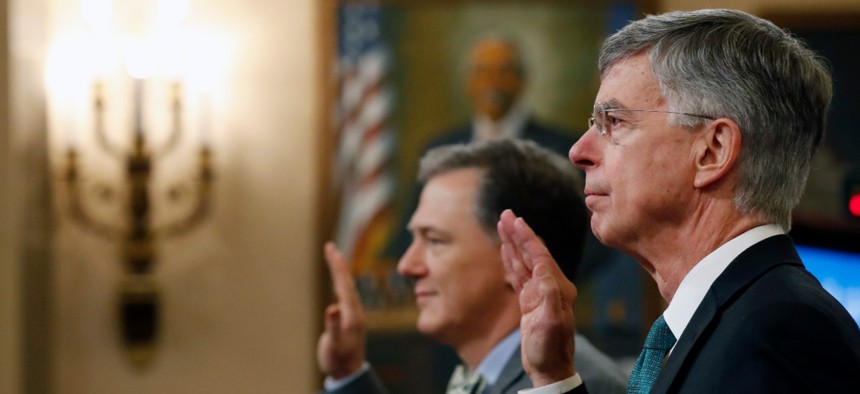What the Careers of Diplomats Can Teach the Rest of Government
Two recent books examine the lives and roles of foreign service officers.
The State Department is receiving a lot of attention these days. In November, career foreign service officers Marie Yovanovitch, William Taylor, George Kent and David Holmes were in the national spotlight during the House hearings on the impeachment of President Trump in relation to his dealings with Ukraine. These previously little known State Department officials, two of whom have since left their positions, received daily press coverage for several weeks.
Two recent books provide deeper insight into the work of the State Department and the life of career foreign service officers. In his memoir The Back Channel: A Memoir of American Diplomacy and The Case for Its Renewal, William J. Burns recounts his 33-year career in the department from 1981 to 2014. And in The Ambassadors: America’s Diplomats on the Front Lines, Paul Richter discusses the experience and multiple assignments of four ambassadors in the Middle East from 2001 to 2017: Ryan Crocker, Robert Ford, Anne Patterson and Chris Stevens.
Both books are highly informative about what government actually does on the front lines. (It would be worthwhile to have similar books describing the jobs of public servants in other departments and agencies.) Burns describes diplomats as harnessing all the tools of American statecraft “from the soft power of ideas, culture and public diplomacy, to economic incentives and sanctions, intelligence-gathering and covert actions, and military assistance and the threat of force—to achieve policy aims. Diplomats are classic organizers, whether in mobilizing the levers of American influence, shaping international alliances, or bridging divides with adversaries.”
While the State Department is facing many current management challenges, the career model of the foreign service—a “rank-in-person” system in which rank remains with employees regardless of the positions they hold—presents an interesting alternative to that of the civil service. What can other agencies learn from the State Department and the careers of the ambassadors Burns and Richter profiled?
Lesson One: Experience Matters
One cannot help but be impressed by the vast experience accumulated by foreign service officers over their careers. When administrations needed what Richter calls “cool heads in hot spots,” they could call upon a cadre of senior career officers with extensive experience in the Middle East. During his career from 1971 to 2012, Ryan Crocker held six ambassadorships. During her career from 1973 to 2017, Anne Patterson held four ambassadorships. Burns served 10 secretaries of State in various capacities, including ambassador to Russia, ambassador to Jordan, assistant secretary for Near Eastern Affairs, undersecretary for Political Affairs and deputy secretary. Each of their positions prepared them for their subsequent assignments and each built an extensive network of contacts and colleagues worldwide, which they tapped into during their assignments.
Lesson Two: Development Matters
Based on “purposeful” assignments throughout their careers, foreign service officers gain experience in different types of positions and in different nations. The four ambassadors Burns and Richter profiled served both in the field and at headquarters during their careers. The foreign service model is based on the importance of mentorship (both formal and informal) during assignments early in an officer’s career. Burns describes his early experience working as minister-counselor for political affairs in Moscow: “There is no playbook or operating manual in the foreign service, and the absence of diplomatic doctrine, or even systematic case studies, has been a long-standing weakness of the State Department,” he wrote. “Throughout my formative years, good mentors mattered most of all–accomplished diplomats from whom I could draw essential lessons about negotiating and leadership. Experience was passed from generation to generation, and I never had a better role model than Tom Pickering.”
Lesson Three: Rank-in-Person Matters
One of the most interesting components of the 1978 Civil Service Reform Act was the creation of the Senior Executive Service, which gave SES members rank-in-person with the expectation of increased mobility within their own departments and across the government. In addition, the new law allowed SES members to take a “political” position with rights to return to a career position after the “political” position. In the State Department, similar provisions have been widely used and seen clearly in the careers of Burns, Crocker, Ford, Patterson and Stevens.
There continue to be few examples of career civil servants in domestic agencies who have had the opportunity to serve the nation in multiple departments and agencies. As the number and importance of cross-agency policy goals continue to increase, there is a growing need for experienced civil servants who can move from agency to agency (or goal to goal) and bring their experience to bear in new situations. In many ways, that was the vision for the Senior Executive Service. The experience of the State Department demonstrates that rank-in-person can indeed be an effective tool for administrations to deploy when they need “cool heads in hot spots.”
Mark A. Abramson is president of Leadership Inc. His most recent book is Government for the Future: Reflection and Vision for Tomorrow’s Leaders (with Daniel J. Chenok and John M. Kamensky). His email address is mark.abramson@comcast.net.
NEXT STORY: GovExec Daily: The Coronavirus Response



